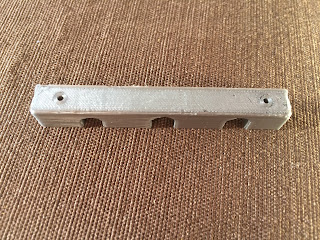Ever heard of the Mike Tyson rule? "Everyone has a plan until they get punched in the mouth". This rule can be applied to a lot of things-even design.
Problem: I recently pulled three ethernet cables to wire my front living room so I could have secured high speed LAN access without upgrading my wireless router. When securing the cables, I had a limited number of cable clips. So I did the best I could and let most of the wires dangle in the basement.
Solution: With my 3D printer-why not print my own cable clips? I could even customize it to the specific sizes of the two cat 6 and one cat 5e cables. Awesome!
Design and Print: Drawing the design was relatively simple. It was drawing three profile of the three ethernet cables cutting out a rectangular body. The first design produced this:
Straightforward and practical. It felt bomb proof but it took 25 minutes to print. Not exactly the most efficient part to replicate 8 to 10 times. So I went ahead and optimized the design.
 |
| I thought printing from this position would result in the strongest print. |
As I started trimming some stuff down, I realized I had the print orientation wrong. As opposed to printing the parts as shown in the above, I should rotate it on its side. This would be the equivalent of taking a flat bar and bending three U-shape hoops in it. When the printer can run the filament along the entire profile, this results in a very strong configuration. So I flipped the print on its side and produced the ultimate design for strength and speed of creation! This 'final' design printed three times faster!
 |
| This is how it would print on the 3d printer. |
 |
| Mass production in the works . . . unfortunately. |
Installation: Here comes Mike Tyson. I went ahead and tried to nail the cable tie and immediately encountered a problem. Nailing my cable tie upside down was very difficult. The angle and positioning I had to hold the hammer, I struck the cable tie. Repeatedly. To the point that it broke.
 |
| This did not survive the Mike Tyson rule. |
Did it look pretty? Nope. Did it satisfy my sense of awesome execution? Nope. Did I get the job done? Yep. And sometimes getting something done is what counts.
 |
| Original cable ties. |
 |
| Painfully hammered flush nails. This took too long to get it right. |
 |
| Bent nails! The hack way of getting it done! |
Conclusion: Next time-before I mass produce a design is to run it by the Mike Tyson rule. Despite your best efforts at what you think is perfection, make sure you test in a live environment or with a real customer!
Until next time. Happy Printing!
 |
| Iterate and test often! |







